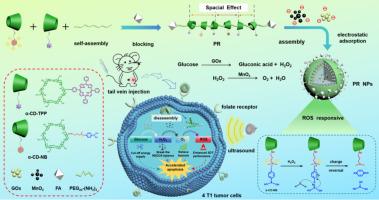Cyclodextrin polyrotaxane based self oxygen supplying nanoparticles for enhancing the sonodynamic therapy mammary cancer performance with a “one-stone-two-birds” strategy
IF 12.5
1区 化学
Q1 CHEMISTRY, APPLIED
引用次数: 0
Abstract
Sonodynamic therapy (SDT) is a novel anti-tumor approach that offers the advantages of deep penetration, high therapeutic efficacy, and minimal damage to normal tissues. However, the organic sonosensitizers tetraphenylporphyrin can inhibit the production of reactive oxygen species (ROS) due to the intermolecular π-π stacking effect, resulting in a poor SDT effect. SDT utilizing oxygen-dependent sonosensitizers are frequently limited by the hypoxic microenvironment characteristic of solid tumors. Herein, we have successfully developed an enhanced SDT self oxygen supplying delivery system based on cyclodextrin polyrotaxane to inhibit the π-π stacking effect between tetraphenylporphyrin molecules and improve the hypoxic microenvironment. A “one-stone-two-birds” strategy was proposed. On one hand, the spatial effect of cyclodextrin and polyrotaxane was utilized to enhance the yield of ROS from the sonosensitizers agent porphyrin. On the other hand, the GOx and manganese dioxide nanozyme were loaded onto polyrotaxane through electrostatic adsorption, enabling the reversal of hypoxic environment at the tumor site through a cascade reaction. Ultimately, the prepared polyrotaxane nanoparticles, combined with targeted accumulation to enhance SDT efficacy and starvation therapy, resulted in a 76 % suppression of tumor growth. This study develops an innovative approach to enhance SDT performance of tetraphenylporphyrin via cyclodextrin polyrotaxane spatial effects, while offering a novel strategy to alleviate tumor hypoxia.

基于环糊精聚轮烷的自供氧纳米颗粒以“一石二鸟”策略增强声动力治疗乳腺癌的效果
声动力治疗(SDT)是一种新型的抗肿瘤方法,具有穿透深度深、疗效高、对正常组织损伤小等优点。然而,有机声敏剂四苯基卟啉由于分子间π-π堆积效应会抑制活性氧(ROS)的产生,导致SDT效果较差。利用氧依赖性超声增敏剂的SDT经常受到实体肿瘤缺氧微环境特征的限制。本文成功开发了一种基于环糊精聚轮烷的增强型SDT自供氧递送系统,以抑制四苯基卟啉分子之间的π-π堆叠效应,改善缺氧微环境。提出了“一石二鸟”战略。一方面,利用环糊精和聚轮烷的空间效应,提高了声敏剂卟啉的活性氧收率;另一方面,通过静电吸附将氧化石墨烯和二氧化锰纳米酶负载到聚轮烷上,通过级联反应逆转肿瘤部位的缺氧环境。最终,制备的聚轮烷纳米颗粒结合靶向积累来增强SDT疗效和饥饿治疗,导致76%的肿瘤生长抑制。本研究通过环糊精聚轮烷空间效应提高四苯基卟啉的SDT性能,同时为缓解肿瘤缺氧提供了一种新的策略。
本文章由计算机程序翻译,如有差异,请以英文原文为准。
求助全文
约1分钟内获得全文
求助全文
来源期刊

Carbohydrate Polymers
化学-高分子科学
CiteScore
22.40
自引率
8.00%
发文量
1286
审稿时长
47 days
期刊介绍:
Carbohydrate Polymers stands as a prominent journal in the glycoscience field, dedicated to exploring and harnessing the potential of polysaccharides with applications spanning bioenergy, bioplastics, biomaterials, biorefining, chemistry, drug delivery, food, health, nanotechnology, packaging, paper, pharmaceuticals, medicine, oil recovery, textiles, tissue engineering, wood, and various aspects of glycoscience.
The journal emphasizes the central role of well-characterized carbohydrate polymers, highlighting their significance as the primary focus rather than a peripheral topic. Each paper must prominently feature at least one named carbohydrate polymer, evident in both citation and title, with a commitment to innovative research that advances scientific knowledge.
 求助内容:
求助内容: 应助结果提醒方式:
应助结果提醒方式:


